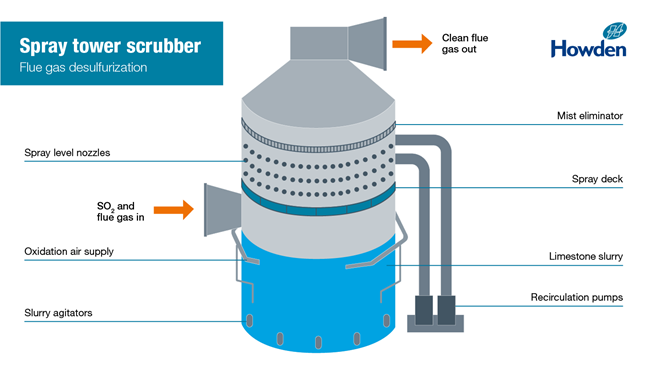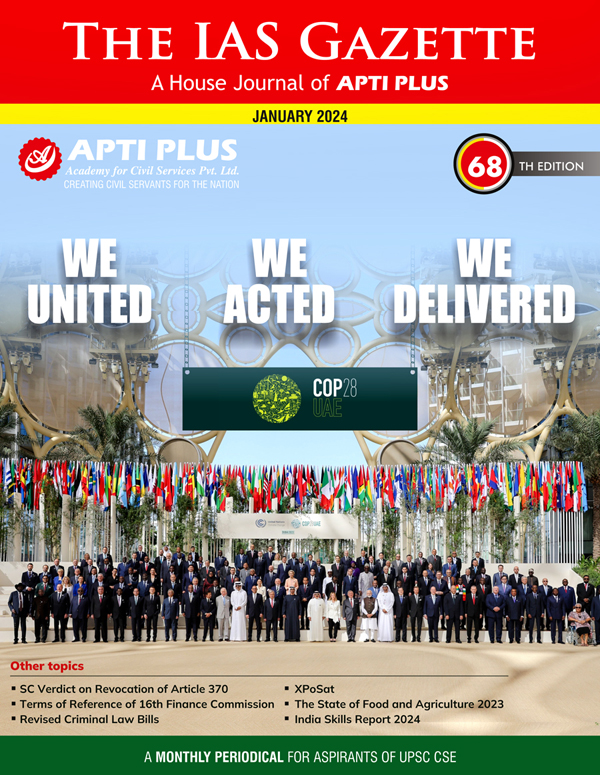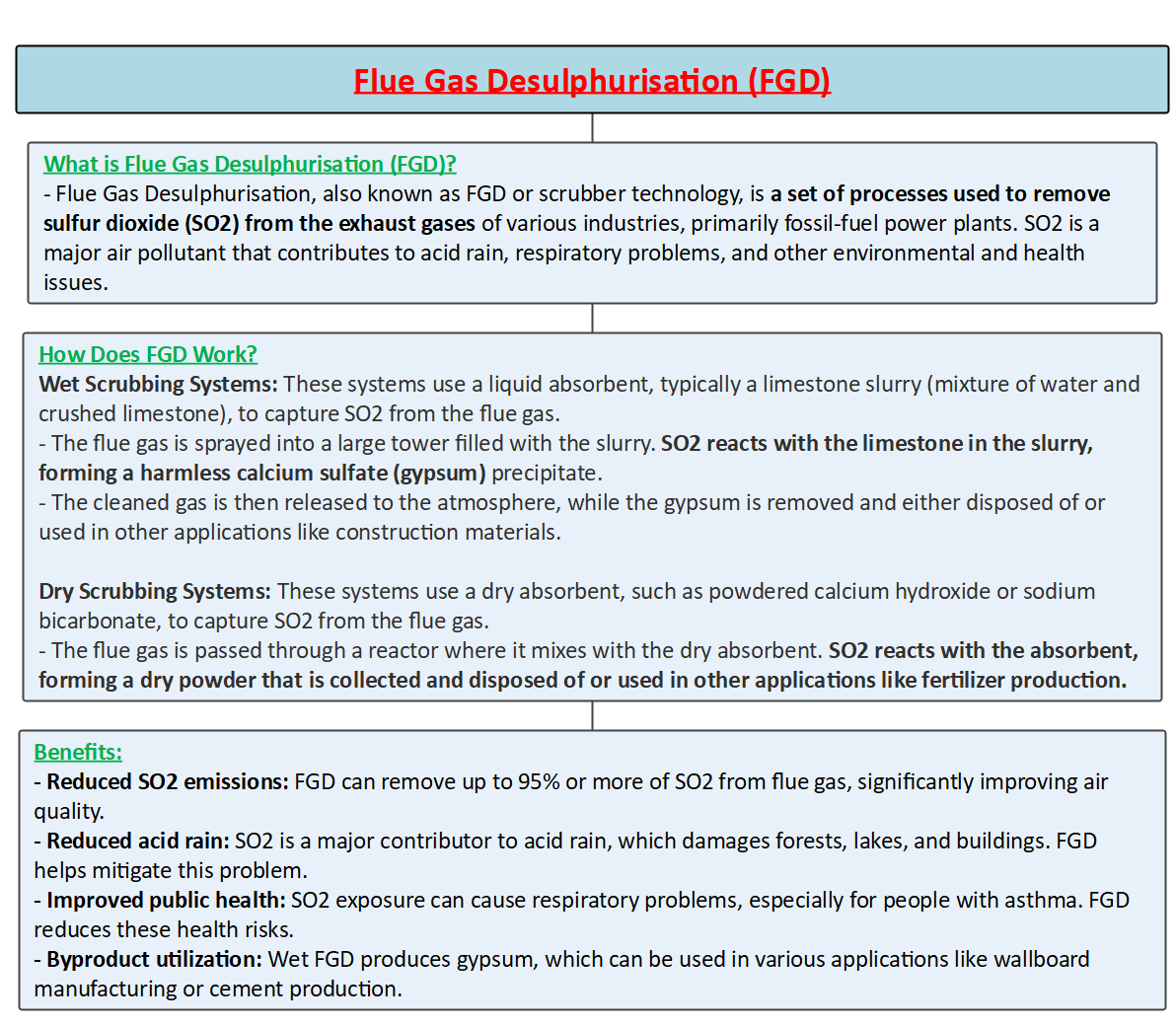Description

Copyright infringement not intended
Picture Courtesy: https://www.howden.com/en-gb/articles/flue-gas-desulfurization-acid-rain
Context: Thermal power plants are required to install Flue Gas De-sulphurisation (FGD) equipment to adhere to emission regulations, as per the guidelines set by the Ministry of Environment.
Details
- The Union Minister for Power and New & Renewable Energy has shared information regarding the installation of Flue Gas De-sulphurisation (FGD) equipment in thermal power plants in India.
- The primary goal of this initiative is to guarantee adherence to emission norms established by the Ministry of Environment, Forest and Climate Change (MoEF&CC) and follow the directives provided by the Central Pollution Control Board (CPCB).
Emission Norms Compliance
- Thermal power plants are mandated to adhere to emission norms specified by MoEF&CC and CPCB.
- Plants located in the eastern region, including Bihar, West Bengal, Odisha, Assam, and Jharkhand, are undergoing up-gradation and installation of emission control equipment.
- Thermal power plants are installing Flue Gas De-sulphurisation (FGD) equipment to comply with Sulphur dioxide (SO2) emission norms.
- Timelines for compliance vary based on the category and location of the power plants:
- Category A: Within a 10 km radius of the National Capital Region (NCR) or cities with a population of over one million (as per the 2011 census) - Compliance by 31st December 2024.
- Category B: Within a 10 km radius of Critically Polluted Areas or Non-attainment Cities - Compliance by 31st December 2025.
- Category C: Areas not included in categories A and B - Compliance by 31st December 2026.

Monitoring and Oversight
- Compliance with emission norms is monitored by CPCB and State Pollution Control Boards (SPCBs).
- Central Electricity Authority (CEA) assists CPCB in monitoring FGD installation progress at thermal power plants, covering stages from feasibility studies to commissioning.
Flue Gas De-sulphurisation (FGD)
- Flue Gas De-sulphurisation (FGD) is a process that removes sulphur dioxide (SO2) from the flue gas (exhaust gas) stream of fossil-fuel power plants and other industrial processes that emit SO2. SO2 is a harmful pollutant that contributes to acid rain, smog and respiratory diseases.
- FGD helps to reduce the environmental impact of SO2 emissions and comply with the emission standards set by the government or international bodies.
|
FGD is a process that uses a sorbent, usually lime or limestone, to react with SO2 in the flue gas and convert it into harmless products. The sorbent can be injected as a dry powder, sprayed as a wet slurry or circulated as a seawater solution. The reaction products can be collected as solid residues, dissolved in water or discharged into the sea.
|
Why is FGD important?
- FGD is important because it reduces the environmental and health impacts of SO2 emissions from fossil-fuel power plants and other industrial processes.
- SO2 is one of the major causes of acid rain, which damages forests, lakes, soils, buildings and monuments. Acid rain also affects aquatic life by lowering the pH of water bodies and leaching toxic metals from sediments.
- SO2 contributes to the formation of secondary pollutants, such as sulphate aerosols, which reduce visibility and increase atmospheric radiation.
- SO2 poses serious health risks to humans and animals.
- Exposure to high levels of SO2 can cause irritation of the eyes, nose, throat and lungs, as well as asthma attacks, bronchitis, emphysema and chronic obstructive pulmonary disease (COPD).
- Long-term exposure to low levels of SO2 can increase the risk of respiratory infections, cardiovascular diseases and lung cancer.
Different types of FGD systems
Wet scrubbing
- This is the most common and effective method of FGD.
- It involves spraying a slurry of alkaline sorbent (usually limestone or lime) into a tower or chamber where it contacts the flue gas.
- The SO2 reacts with the sorbent and forms calcium sulphite or sulphate, which is then removed as a sludge or gypsum.
- The treated flue gas exits the tower with a reduced SO2 concentration and a characteristic white plume of water vapour.
Spray-dry scrubbing
- This is a variation of wet scrubbing that uses a lower amount of water and a higher temperature.
- The sorbent slurry is atomized and sprayed into a chamber where it evaporates and forms fine dry particles that react with SO2 in the flue gas.
- The reaction products are then collected by an electrostatic precipitator or a fabric filter.
- The advantage of this method is that it produces less wastewater and avoids scaling problems in the scrubber.

Wet sulphuric acid process
- This is a method that recovers sulphur in the form of commercial-quality sulphuric acid.
- The flue gas is first cooled and moistened, then passed through a catalytic converter where SO2 is oxidized to SO3.
- The SO3 is then absorbed in water and forms sulphuric acid, which can be sold or used for other purposes.
- The drawback of this method is that it requires high capital and operating costs and produces corrosive waste.
Dry sorbent injection
- This is a simple and low-cost method of FGD that involves injecting powdered hydrated lime (or other sorbent material) into the exhaust ducts of the power plant or industrial process.
- The sorbent reacts with SO2 in the flue gas and forms solid compounds that are then captured by an existing particulate control device, such as an electrostatic precipitator or a fabric filter.
- The disadvantage of this method is that it has lower efficiency and higher sorbent consumption than wet scrubbing.

Conclusion
- FGD technology is constantly evolving, with research and development focused on improving efficiency, reducing costs, and finding new applications for captured byproducts. As environmental regulations become stricter and the need for cleaner air grows, FGD is expected to play an increasingly important role in reducing industrial emissions and mitigating the impacts of climate change.
|
PRACTICE QUESTION
Q. With carbon removal technologies still in their infancy, what are the ethical and feasibility concerns surrounding large-scale implementation of negative emissions strategies? To what extent can they be relied upon to compensate for continued emissions, and what role should they play in our climate mitigation strategy?
|















